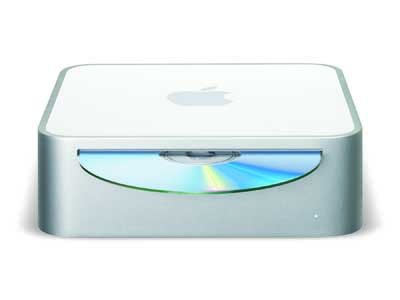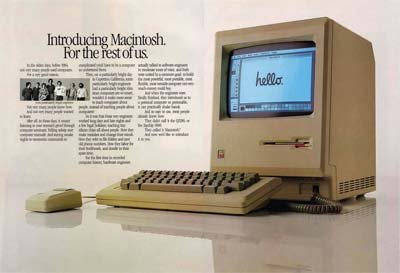COMPUTERS | History came full circle this week: Ahmad Humeid discovers that Apple’s new Mac mini and an old story from 1979 have a lot in common

As Apple chief Steve Jobs took the stage at San Francisco’s Moscone Center on January 11, 2005 to deliver this year’s Macworld Expo keynote presentation, the Macintosh faithful were holding their breath. For weeks the Macintosh industry rumour mill has been awash in whisperings that Apple will be introducing a groundbreaking new product: A screen-less Macintosh priced under US$ 500.
When Jobs finally held out the rumoured computer for the over 4000 attendees to see, they went wild. Not only where the rumours true, but Apple has again blown its fans away with a surprising design. This Mac mini is so small it can fit into the palm of an adult hand!
For years (even decades!) people have been urging Apple to produce a cheaper Macintosh to stem the rise of the Windows-Intel platform, to no avail. The perception of ‘Macintosh is expensive’ runs deep. Even the consumer oriented iMac (priced at around US$, 1300), which Jobs introduced after his return to Apple in the late 90s could not change this. This perception is largely of Apple’s own making as it fashioned itself, for a long time, in the image of high-end brands like Mercedes and BMW: High quality with the price to mach it.
But with the wild success of its iPod digital music player Apple seems ready to break new ground. It is hoped that many iPod fans, who currently use their players with their Windows PCs, consider making the switch from Windows to Mac, or, alternatively, consider the Mac as a second, digital media oriented computer.
Back to the future?
With the introduction of a $500 dollar Mac a historical episode of personal computing comes full circle. With the benefit of hindsight, this episode holds a delicious irony that only can be understood if one delves deeper into Apple’s history.
If you trace back the story of the Macintosh, you will arrive at the year 1979, when Jef Raskin, who at the time was the 36 year old manager of Apple’s publication department, proposed to his management a project to develop a revolutionary new computer.
 Raskin writes in his biography: “I conceived of the Macintosh (and coined the name) in response to my belief that to reach a larger marketplace, future computers had to be designed from the user interface out.”
Raskin writes in his biography: “I conceived of the Macintosh (and coined the name) in response to my belief that to reach a larger marketplace, future computers had to be designed from the user interface out.”
Raskin, who studied math, philosophy, computer science and music and worked at several computer related companies in the 60’s and 70’s started to author the design for this new computer. His writings evolved into a collection of documents known as ‘The Book of Macintosh’. Amazingly, one of the principles Raskin set was that his Macintosh should not cost more than 500 Dollars!
As Steve Jobs started to take over the Macintosh project around 1979, the projected price tag for the yet unborn Mac started going up as he requested more features. He told Raskin: “Don’t worry about price, just specify the computer’s abilities.”
Raskin did not like that at all and shot back with the following sarcastic memo.
Raskin’s rant
In his memo, dated 2 October 1979 Raskin wrote:
“It is impossible to merely start with the desired specifications: it is too easy. We want a small, lightweight computer with an excellent, typewriter style keyboard. It is accompanied by a 96 character by 66 line display that has almost no depth, and a letter-quality printer that also doesn’t weigh much, and takes ordinary paper and produces text at one page per second (not so fast so that you can’t catch them as they come out). The printer can also produce any graphics the screen can show (with at least 1000 by 1200 points of resolution). In color.
The printer should weigh only a fraction of a pound, and never need a ribbon or mechanical adjustment. It should print in any font. There is about 200K bytes of main storage besides screen memory and a miniature, pocketable, storage element that holds a megabyte, and costs $.50, in unit quantity.
When you buy the computer, you get a free unlimited access to the ARPA net, the various timesharing services, and other informational, computer accessible data bases. Besides an unexcelled collection of application programs, the software includes BASIC, Pascal, LISP, FORTRAN, APL, PL1, COBOL, and an emulator for every processor since the IBM 650.
Let’s include speech synthesis and recognition, with a vocabulary of 34,000 words. It can also synthesize music, even simulate Caruso singing with the Mormon tabernacle choir, with variable reverberation.
Conclusion: starting with the abilities desired is nonsense. We must start both with a price goal, and a set of abilities, and keep an eye on today’s and the immediate future’s technology. These factors must be all juggled simultaneously.”

The expensive Mac
Raskin eventually left Apple in frustration in 1981, three years before the launch of the first Macintosh. Gone was his vision of a $500 computer. Due to technical features as well as Apple’s extravagant advertising expenditures, the first Macintosh was priced at US$ 2,500!
Now in 2005, we finally have a $500 Mac that can do what Raskin has sarcastically outlined as ‘pie in the sky’ in 1979. It just took 25 years to happen!
Comments
2 responses to “The $499 Macintosh: a dream of a quarter century comes true!”
Ahmad,
I wish Mr. Raskin’s original idea were followed! I am sure Bill Gates and his always-crashing Windows would not have seen see the light of the day.
Great blog you got here by the way…
Regards,
Bill Ainashe
Washington, DC
WWW.AINASHE.ORG
im going for 1 soon
an apple a day keeps the Dr away